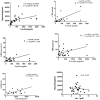Iron metabolism abnormalities in autoimmune hemolytic anemia and Jianpishengxue keli can ameliorate hemolysis and improve iron metabolism in AIHA mouse models
- PMID: 36576329
- PMCID: PMC9809345
- DOI: 10.1080/07853890.2022.2157475
Iron metabolism abnormalities in autoimmune hemolytic anemia and Jianpishengxue keli can ameliorate hemolysis and improve iron metabolism in AIHA mouse models
Abstract
Objective: Autoimmune hemolytic anemia (AIHA) is rare heterogeneous disorder characterized by red blood cell (RBC) destruction via auto-antibodies, and after RBC is destroyed, proinflammatory danger-associated molecular patterns including extracellular hemoglobin, heme, and iron which causing cell injury. And oxidative stress represents one of the most significant effects of chronic hemolysis. Jianpishengxue keli can improve the symptoms of anemia patients with kidney disease and tumors and are beneficial in promoting recovery from chronic inflammation. Therefore, it is presumed that Jianpishengxue keli can improve the symptoms of AIHA. We aimed to investigate iron metabolism in AIHA and effects of Jianpishengxue keli on AIHA murine model.
Methods: Nineteen hemolytic episode AIHA patients, 10 remission patients and 10 healthy controls (HCs) were enrolled in this study. Serum hepcidin, ferritin and other related indicators of iron metabolism were measured. Mouse models of AIHA were established and received high, medium, or low doses of Jianpishengxue keli by gavage daily for 14 and 28 days respectively. The level of RBCs, Hb, bilirubin, LDH, hepcidin, and the expression level of hepcidin mRNA, and hepatic ferroportin 1(FPN1) protein were evaluated.
Results: Serum hepcidin in hemolytic episode AIHA patients and remission patients were significantly higher than that in HCs (p = 0.0083 and p = 0.0473, respectively). Serum ferritin in hemolytic AIHA patients was significantly higher than that in HCs (p = 0.008). Serum transferrin saturation levels are increased in patients with AIHA[ (57.21 ± 8.96) %]. EPO in hemolytic group was higher than that in healthy control (p<0.05). In AIHA mouse models, IBIL decreased after 14 days of high dose drug intervention. After 28 days, TBIL and IBIL both significantly decreased in all dose groups and LDH significantly decreased in the medium-and high-dose groups. Body weight improved, and the level of RBCs, Hb and hepcidin in the high-dose group returned to normal. After 14 and 28 days of intervention, hepatic hepcidin mRNA in all dose group significantly decreased. Hepatic FPN1 protein which were significantly lower in the AIHA mouse models, increased in all dose groups after drug intervention for 28 days.
Conclusion: Iron metabolism abnormalities exists in AIHA patients and Jianpishengxue keli can ameliorate hemolysis and improve iron metabolism in AIHA mouse models.KEY MESSAGESIron metabolism abnormalities exists in hemolytic episode AIHA patients. Hepcidin and ferritin levels significantly elevated and also correlated with the severity of AIHA patients. Jianpishengxue keli can ameliorate hemolysis and prompt the recovery of AIHA.
Keywords: Autoimmune hemolytic anemia; Jianpishengxue Keli; hepcidin; immune inflammation; iron metabolic.
Conflict of interest statement
None of the authors have a financial or proprietary interest in any material or method mentioned. The authors are responsible for the content and writing of the paper. All authors have completed and submitted the ICMJE form for disclosure of potential conflicts of interest. No potential conflict of interest was reported by the author(s).
Figures



Similar articles
-
miR-150 regulates B lymphocyte in autoimmune hemolytic anemia/Evans syndrome by c-Myb.Int J Hematol. 2018 Jun;107(6):666-672. doi: 10.1007/s12185-018-2429-z. Epub 2018 Feb 27. Int J Hematol. 2018. PMID: 29488168
-
[The clinical significance of CD(4)(+)CD(69)(+) T lymphocytes in patients with autoimmune hemolytic anemia/Evans syndrome].Zhonghua Nei Ke Za Zhi. 2018 Sep 1;57(9):656-660. doi: 10.3760/cma.j.issn.0578-1426.2018.09.007. Zhonghua Nei Ke Za Zhi. 2018. PMID: 30180450 Chinese.
-
Autoimmune hemolytic anemia in hospitalized patients: 450 patients and their red blood cell transfusions.Medicine (Baltimore). 2020 Jan;99(2):e18739. doi: 10.1097/MD.0000000000018739. Medicine (Baltimore). 2020. PMID: 31914091 Free PMC article.
-
Rheumatoid anemia.Joint Bone Spine. 2011 Mar;78(2):131-7. doi: 10.1016/j.jbspin.2010.05.017. Epub 2010 Sep 18. Joint Bone Spine. 2011. PMID: 20851655 Review.
-
[Autoimmune hemolytic anemia].Nihon Rinsho. 2008 Mar;66(3):520-3. Nihon Rinsho. 2008. PMID: 18326320 Review. Japanese.
References
-
- Jäger U, Barcellini W, Broome CM, et al. . Diagnosis and treatment of autoimmune hemolytic anemia in adults: recommendations from the first international consensus meeting. Blood Rev. 2020;41:100648. - PubMed
-
- Ganz T. Anemia of inflammation. N Engl J Med. 2019;381(12):1148–1157. - PubMed
-
- Means RT, Jr, Dessypris EN, Krantz SB.. Inhibition of human erythroid colony-forming units by interleukin-1 is mediated by gamma interferon. J Cell Physiol. 1992;150(1):59–64. - PubMed
-
- Means RT, Jr, Krantz SB.. Inhibition of human erythroid colony-forming units by gamma interferon can be corrected by recombinant human erythropoietin. Blood. 1991;78(10):2564–2567. - PubMed
Publication types
MeSH terms
Substances
LinkOut - more resources
Full Text Sources
Research Materials
